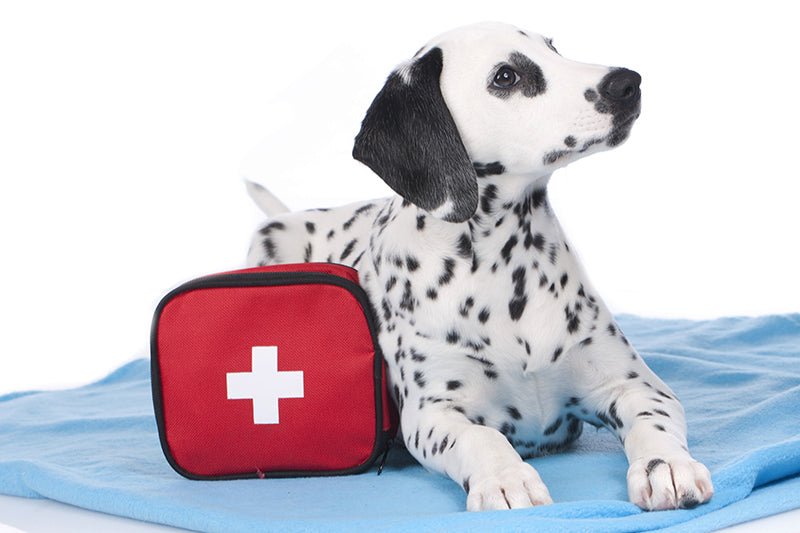Summer time is vacation time!
Of course, our dogs shouldn't be missing during the best time of year. Here is some information on what is needed in the first-aid kit for your dog and how you can provide first aid in an emergency. Prepare well and the holiday will become a great experience for you and your companion!
Traveling with a dog: how to prepare
In order to travel stress-free, take care of the following documents and vaccinations well in advance:
- Pet passport if traveling abroad
- Copy of dog liability insurance policy
- Tag for the collar with your address and phone number
- Vaccination certificate with all necessary vaccinations for the holiday destination (rabies vaccination is mandatory across Europe)
- Consider chipping your dog in case he gets lost
- Your vet’s telephone number for consultation in an emergency
- Checklist for your dog’s first-aid kit
If your dog gets injured while on holiday, you can provide first aid yourself with a well-equipped kit for minor injuries. Think of the following items before starting your journey, so that you can react quickly and provide optimal care to your dog:
- Gauze compresses & bandages
- Self-adhesive, flexible bandages for wound care and support bandages
- Clinical thermometer
- Disposable gloves
- Disposable syringes (5 - 10 ml depending on the dog’s size) for administration of medication
- Rolled wadding for paw bandages
- Something to help relax during stress of travel (Bach flowers or Calm & Relax herbs, or our Calming Bundle)
- Tweezers
- Blunt scissors
- Flea comb
- Mild shampoo, for example Fur Harmony Shampoo with coconut.
- Tick remover
- Tick protection (tick shield, tick spray or spot on, or our easy to use Summer Season Snack)
- Environment cleaner spray
- Aniforte Care Wipes for quick and easy cleaning
- Mild wound and healing ointment for small wounds or abrasions
- Cooling pads
- Disinfectant spray for small wounds
- Flashlight (has always proven itself in an emergency)
- Ear cleaner with chamomile
- Medicines for stomach upset, diarrhoea, vomiting or nausea, for example Moor Mud or Morosan
- Zinc ointment for wound care
- An Elizabethan collar for just in case, the padded ones or inflatable are more comfortable for your dog.
The right behaviour during an emergency
If an emergency occurs and your dog is injured, watch out for yourself, but also for other people involved. Depending on the degree of injury, an injured dog often defends itself against people who want to provide first aid out of fear or pain. In the worst case, he will bite.
Watch your dog closely in such situations, he may react differently than usual. It is also advisable to tie the dog's snout with a muzzle if needed. A leash can also help in the event of a serious injury. Then go to the nearest vet or a clinic, because unfortunately you won't get very far with your first-aid kit if it is a serious accident or emergency.
First aid in case of illness
More likely than serious accidents are the small, yet annoying issues your dog may experiences while traveling. With our travel pharmacy checklist, you are prepared for these and can carry out the first aid yourself.
Minor wounds and injuries
Injuries to the paws, whether claw or ball of the foot, always look dramatic because they are accompanied by profuse bleeding. But they are rarely threatening. You should clean and disinfect the wound and apply a paw bandage. If you are unsure about the depth of the injury, the wound should be checked by a veterinarian. This mainly applies to injuries in the leg area in order to rule out serious damage to ligaments and tendons. You should clean and disinfect abrasions. Also, try to steer clear of getting the wound wet or muddy.
If the dog licks his wounds, a loose bandage can help during the night. Otherwise the wound should be exposed to air. You can use a zinc ointment to improve wound healing, which you should always have with you. This is also where and Elizabethan collar could come in handy.
If your dog gets into a fight with bite injuries while on vacation, the extent of the wounds must first be assessed. If the outcome was still mild, you can rinse, clean and then disinfect the wounds. Often it is the bruising of the tissue around the bite wound that hurts. With cleaning and cooling, you can give your dog relief. However, if the bite wounds are serious, consult with a local veterinarian.
Insect bites
Bee or wasp stings are very common on vacation. In general, dogs manage well with insect bites and a slight swelling of the puncture site should not be too worrying. You can provide your dog with additional cooling by wrapping a cooling pad into a damp towel and placing it on the bite.
However, if your dog shows allergic symptoms, such as shortness of breath, accelerated heartbeat and pulse, vomiting or swollen lymph nodes, immediately see a veterinarian. Many pet owners already know about their dog's allergic reactions and have appropriate antihistamine tablets on hand or in their first-aid kit.
If your dog has swallowed a stinging insect, it is important for you to keep cool, because dogs tends to panic. It is important to see which insect it is. A bee stings only once, but a wasp stings several times and must be removed immediately. Stings in the mouth / throat area can swell the mucous membranes and block the airways. As an immediate aid, use ice cubes for cooling. After that, see a veterinarian as quickly as possible.
Overheating / sunstroke
Because dogs cannot sweat like humans, they are more sensitive to heat. Most of the heat is regulated by panting, but also by the pads of the paws. Warm air is exhaled through the mouth and cold air is inhaled through the nose. Unfortunately, this type of cooling is less effective than it is in humans, which is why dogs are much more prone to overheating.
Sunstroke occurs when your dog has been exposed to heat for too long. As a result, your furry friend pants very hard with fast, shallow breathing or begins to stumble. Often dogs just lie there and refuse to walk until they become unconscious. First, look for a shady spot and cool off with a wet towel that you put over your dog, another one under his head to draw the heat out. Make sure to re-wet the towels regularly.
Symptoms for overheating or heat stroke are similar. But while the sunstroke is on the head, heat stroke affects the entire cardiovascular system and the entire body radiates intense heat. Panting and a high pulse are usually accompanied by glassy eyes, vomiting and a deep red to bluish tongue. In such a case, your dog’s blood circulation can fail. Wet towels help here as well, but try not to overwhelm the circulation. It is best to first cool the paws, then the stomach area, the rest of the body and finally the head. You should repeat this procedure often and let your dog rest in the shade.
In order to avoid overheating, choose a route with shady areas, forests or lakes on your excursions so that the dog can seek appropriate cooling. It is also advisable to adjust the pace to the local temperatures. A place in the shade for your furry friend is also the right choice on the beach or lake. At bathing areas, make sure that your dog does not spend too much time splashing around in the water and dogs should avoid swimming on a full stomach, just like us humans.
Vomiting and diarrhoea
Vomiting and diarrhpea can have a variety of causes. Excitement, stress, change in diet to new food, or simply travel sickness, all of this can cause your dog to have an upset stomach. The pet can also have eaten leftover food, rubbish, poisonous plants or he drank unclean water. Especially when you are on vacation at a lake, many dogs take the opportunity to quench their great thirst with dirty water. This usually leads to thin stools. Dogs should not drink large amounts of salty sea water, as it can lead to vomiting, diarrhoea and poisoning.
Regardless of the cause, if your dog has severe diarrhoea, he should fast for 24 hours and only drink fresh water to avoid dehydration. Enjoy a day of rest with your dog, without too much activity. When the stomach has calmed down, you can start with a small meal and add slippery elm bark syrup to calm the digestive system. If this is not easy to make while you are away our Moor Mud can be more convenient. For a small, light meal, for example, boiled beef or chicken with carrot soup have proven themselves useful. You can also add freshly cooked broth to make up for the loss of water. You should avoid oils for a couple of days. The best thing to do is to rebuild the intestinal flora with a natural intestinal regulator.
If the diarrhoea persists despite these measures and you continue to notice mushy, soft to liquid excretions from your dog, this can indicate a loss of fluid. Encourage him to drink to counter this. Sufficient fresh water is a basic requirement for your pet to relax. If fever, fatigue and apathy are added as symptoms, a veterinarian should be consulted.
Grooming
During a beach vacation, sand and salt water can dry out your dog's fur and skin over time. Longer fur in particular tends to become matted. So shower your friend with fresh water every day. Proper grooming with an extensive bath and mild shampoo should not be forgotten. In addition, you can use a natural conditioner for the dull coat to give the skin and coat an extra dose of care.
We wish you and your dogs a wonderful holiday!



